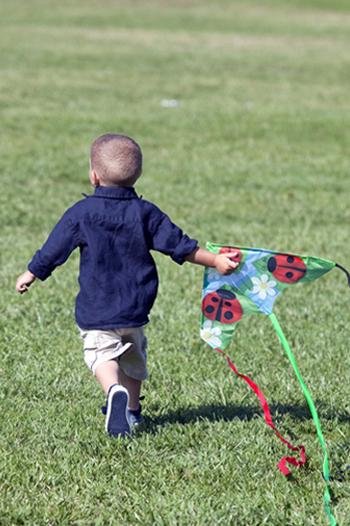It's windy out there
Duration/age

The weather has changed and the wind is blowing a gale.
What do you do? Do you stay inside where it is warm and toasty or do you go outside and brave the wild weather?
If you stay inside, look out the window and talk together about what you notice. Can you see the wind lifting up the leaves and blowing them high into the sky? Are the branches on the trees moving and bending in the wind? What else can you see?
The wind is so strong that it’s blown over the pot plant by the barbecue.
Oh no! The dog’s water bowl is blowing across the yard.
If you are brave enough to go outside, your child can get active and burn off some energy.
Chase after the leaves that are blowing around. How many can you catch? Is it easier to catch the leaves that are down lower to the ground or the ones blowing up high up in the air?
You could help your child to make a kite and try flying it. Does the wind catch the kite straight away and lift it high into the air? Or do you need to run along with the kite trailing behind you before it catches and lifts off?
The wind’s so strong today it feels like it could blow us over.
The wind’s not as strong today so you might need to run with your kite before the wind will catch it.
Alternative tools
- Bubbles
- A wind sock
- A kite
Skills this activity improves
Why does this matter?
Talking with your child about the different weather conditions helps them to develop noticing skills and to develop language to describe what they see.
As they begin to notice what is happening around them they are learning to sort, classify and group objects and events. Sorting, grouping and classifying helps children to identify what language to use when describing the object and how to interact with it.
When you talk to your child about the wind, they are learning about measurement. As they try and catch leaves or fly a kite they will be using words to describe height, speed, strength and distance. These are all forms of measurement.
What does this lead to?
Talking about and exploring the natural and everyday environment with your child will help them to develop the skills to notice, take risks and ask questions. Even if your child does not have a natural disposition to be creative and curious, by exploring and posing questions you are helping your child to experiment with different ways of thinking.
As children explore and interact with the wind they are learning to make predictions about how and when things will happen. By noticing what is happening they begin to use language to describe what they see. Often they will start by describing how far something went or how quickly it happened. These are early forms of measurement.
Language to use
- Wind
- Direction
- Ground, sky
- Moving, blowing, lifting, pushing, bending
- Fast, slow, strong, soft
Questions to use
- Where does the wind come from?
- Does the wind only blow things along the ground?
- Are there things that are too big to be blown over?
Useful tips
- You might also like to take a look at the Blowing bubbles activity.
- Remember to talk to your child in your home language.
More ideas
- Make a wind tree. Thread different objects onto threads of string and hang them in a tree. Watch the wind catch them and blow them around.
- Create wind chimes to hang outside.
Variation by age
Birth to two year olds
- Blow bubbles and watch them lift up into the sky.
Three to five year olds
- Blow bubbles and watch them lift up into the sky.
- Create your own family flag or wind sock to fly on a windy day.
Questions to ask
- How high will the bubble fly?
- Will the bubble go under the tree?
- How many bubbles are there?
- Which one is bigger?
- Which one is fastest?
Questions to ask
- Do the bubbles travel faster when the wind is stronger?
- What happens to the flag when the wind isn’t blowing?
- Do smaller bubbles move faster than big bubbles?
- Can you see the wind?
Language to use
- Fast, slow
- High, low, far, further, nearest, closest
- Big, small, total, lots
Language to use
- Fast, slow
- High, low, further, nearest, closest
- Big, small, total, lots


